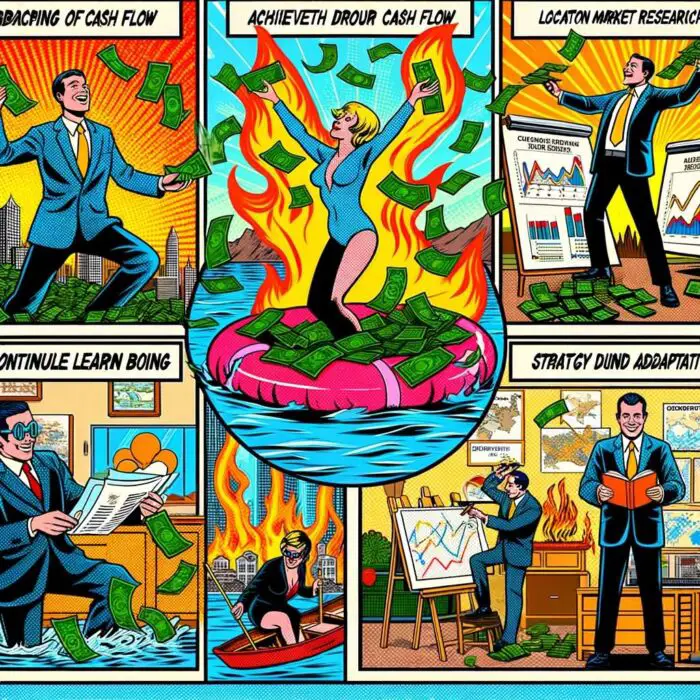In the shifting landscape of personal finance, one theme resonates clearly: the aspiration towards financial independence and the possibility of early retirement. As many people set out on this exciting and challenging journey, they come across a spectrum of strategies and tools to leverage. Among them, one stands out for its enduring allure and proven track record: real estate. An integral part of the Financial Independence, Retire Early (FIRE) movement, real estate investment has proven to be a formidable vehicle for wealth creation and a favored path to financial independence.

Why does real estate carry such weight in the FIRE movement? The answer lies in its unique characteristics as an investment. Real estate is a tangible asset that one can touch, see, and use. This tangibility brings a sense of control and stability that is often comforting to investors. Beyond the tangibility, real estate offers dual revenue streams: from the potential for regular rental income, offering a consistent cash flow, to the appreciation in property value over time, providing opportunities for capital growth. This combination can accelerate wealth accumulation and propel you towards your financial goals.
Furthermore, real estate plays a critical role in portfolio diversification. It often behaves differently than other types of investments like stocks and bonds, offering a buffer in times of market volatility. Its correlation with inflation allows it to act as a hedge, preserving the value of your wealth in the face of rising prices. Moreover, real estate also offers a multitude of tax advantages, including deductions and credits, which can significantly enhance net returns.

Vital role of real estate within the FIRE movement
In this article, we aim to delve deeper into the vital role of real estate within the FIRE movement. We’ll unravel the core concepts of real estate investing, explore how it facilitates the path to financial independence, and take you through the success stories of those who have successfully tread this path. We will also equip you with practical steps to kickstart your own real estate investing journey, highlighting useful tools and resources and sharing strategies for risk management and long-term success.
Whether you’re a seasoned FIRE follower who has been methodically building your investment portfolio, or a financial independence newbie just starting to navigate this captivating landscape, this comprehensive guide aims to illuminate the potential of real estate as a key ally in your pursuit of financial freedom. By the end of this exploration, we hope to inspire you to consider real estate as a robust pillar in your FIRE journey. Are you ready to delve into the nexus of real estate investing and financial independence? Let’s embark on this enlightening journey together.

The Basics of Real Estate Investing
The realm of real estate investing is vast and diverse, offering a plethora of opportunities for investors with varying risk appetites, capital, and goals. Understanding these various avenues can enable you to make informed decisions aligning with your financial independence goals.

Types of Real Estate Investing
- Rental Properties: This is one of the most common forms of real estate investing. It involves purchasing residential or commercial properties to rent out to tenants. The landlord, as the owner is referred to, can potentially enjoy a steady stream of rental income, which can be a cornerstone of a FIRE strategy. This income can either supplement other earnings or, eventually, replace them entirely.
- House Flipping: This strategy involves buying properties at a relatively low cost, often because they need repair or updating. After making necessary improvements, investors then sell – or flip – these houses for a profit. While house flipping can yield significant returns, it also requires a good understanding of the real estate market and renovation costs.
- Real Estate Investment Trusts (REITs): REITs offer a way to invest in real estate without having to buy physical property. Instead, you buy shares of a company that owns and manages real estate. REITs can be a great way to gain exposure to real estate with less capital and without the responsibilities of property management.
Understanding Key Real Estate Investing Concepts
- Cash Flow: This is the net income from a real estate investment after mortgage payments and operating expenses have been made. A positive cash flow means the property is generating a profit, providing a steady income stream.
- Appreciation: Over time, the value of real estate properties tends to increase, or appreciate. This appreciation can lead to significant wealth accumulation, especially when combined with the power of leverage.
- Tax Advantages: Real estate investors can benefit from various tax advantages. These include deductions for mortgage interest, property taxes, operating expenses, depreciation, and more.
- Leverage: Real estate is one of the few investment vehicles where using the bank’s money couldn’t be easier. The ability to make a down payment, leverage your capital, and thus increase your overall return on investment is incredible.

Risks and Challenges Associated with Real Estate Investing
However, it’s not all sunshine in the world of real estate investing. Like any investment, real estate comes with its own set of risks and challenges. Market fluctuations can affect property values and rental income. Properties may sit vacant, and unexpected repair or maintenance costs can arise. Additionally, managing properties can be time-consuming and stressful, particularly for DIY landlords.
By fully understanding these risks and implementing effective risk management strategies, you can position yourself to reap the benefits of real estate investing while mitigating potential downsides. As you delve into real estate investing, remember to keep your financial independence goals at the forefront, ensuring your strategy aligns with your journey towards FIRE.
source: Chris Invests on YouTube
How Real Estate Contributes to Financial Independence
Building wealth through real estate is not merely about purchasing properties and hoping for the best. Instead, it’s about strategically leveraging real estate’s unique characteristics to drive financial growth and stability, contributing to the ultimate goal of financial independence.
Potential for Passive Income Through Rental Properties
One of the pillars of the FIRE movement is the creation of passive income streams, which are earnings requiring little to no daily effort to maintain. Rental properties perfectly fit into this strategy. As a landlord, once you’ve set up the property and found reliable tenants, the rent checks can continue to flow with relatively little ongoing effort. This passive income can replace or supplement your active income (like a salary), helping you inch closer to financial independence.

Appreciation of Property Value Over Time
While regular rental income is a tangible benefit of real estate investment, the long-term value lies in a property’s potential appreciation. Over time, as cities grow and develop, the land under your property can become increasingly valuable. It’s a long game, and real estate markets can fluctuate, but historically, property values have generally followed an upward trajectory. The increase in property value can significantly contribute to your net worth, pushing you further along your FIRE journey.
Tax Benefits of Owning and Investing in Real Estate
Tax efficiency is a key consideration in any financial independence strategy. Real estate shines in this aspect, offering several tax benefits that can increase your overall returns. These include deductions for mortgage interest, property taxes, and maintenance expenses. Additionally, there are depreciation benefits, which let you deduct a portion of the cost of the property over several years. Plus, when you sell a property, you can leverage the 1031 exchange to defer capital gains tax, preserving more of your wealth for reinvestment or supporting your retirement lifestyle.

Diversification Benefits in an Investment Portfolio
The importance of diversification in a robust financial independence strategy cannot be overstated. Spreading your investments across different types of assets can cushion your portfolio against volatility in any one area. Real estate, with its unique performance characteristics and weak correlation with other asset classes like stocks or bonds, can provide this needed diversification. Therefore, incorporating real estate into your portfolio can add stability, reducing risk, and enhancing returns over the long term.
By harnessing these aspects of real estate investment, you can create a robust and diverse portfolio that accelerates your path to financial independence. Remember, the journey to FIRE is not a sprint but a marathon. The key to success lies in careful planning, diligent execution, and the patience to allow your investments to bear fruit.
source: Ramsey Everyday Millionaires on YouTube
Real-Life Examples: Successful FIRE Pursuers via Real Estate
To truly understand the power of real estate as a path to financial independence, let’s delve into the inspiring stories of individuals who have achieved FIRE through astute real estate investments. These real-life examples showcase the diverse approaches they took and the valuable lessons we can glean from their journeys.

Profiles of Individuals Who Have Achieved FIRE Through Real Estate
- Sarah and Mark: Sarah and Mark began their real estate journey by purchasing a small duplex as their primary residence. They lived in one unit while renting out the other, allowing the rental income to cover a significant portion of their mortgage. Over time, they acquired additional rental properties, leveraging the cash flow from their investments to pay down debts and reinvest in new properties. Today, their real estate portfolio generates substantial passive income, enabling them to achieve financial independence at a relatively young age.
- Robert and Emily: Robert and Emily took a different route to FIRE by specializing in house flipping. With a keen eye for undervalued properties and a knack for renovations, they bought properties in need of repair, revamped them, and sold them for a profit. Their well-executed flips generated substantial returns, which they reinvested into additional projects. The combination of successful flips and prudent property acquisitions allowed them to accumulate a sizable real estate portfolio that fuels their financial independence.
Analysis of Their Real Estate Investment Strategies
- Sarah and Mark’s Strategy: Sarah and Mark focused on acquiring rental properties, leveraging the rental income to cover expenses and build equity. They diligently researched and purchased properties in high-demand areas with favorable rent-to-purchase price ratios. Their strategy allowed them to benefit from both cash flow and property appreciation, steadily growing their real estate empire.
- Robert and Emily’s Strategy: Robert and Emily specialized in the art of house flipping. They honed their skills in identifying undervalued properties, negotiating favorable deals, and executing cost-effective renovations. Their attention to detail and careful market analysis contributed to their success in selling properties for a profit. They reinvested the proceeds into new projects, compounding their wealth accumulation.

Lessons Learned from These Individuals
- Embrace the Power of Cash Flow: Whether through rental properties or successful house flips, generating positive cash flow is vital. Cash flow provides a steady income stream that can fund your lifestyle and further investment opportunities.
- Location and Market Research Matter: Sarah and Mark’s success stemmed from carefully selecting properties in high-demand areas. Thorough market research and understanding local dynamics can help identify properties with favorable growth potential and rentability.
- Diligent Due Diligence: Both Sarah and Mark and Robert and Emily emphasize the importance of thorough due diligence. Carefully analyzing the numbers, understanding market trends, and conducting property inspections are critical steps to mitigate risks and maximize returns.
- Continual Learning and Adaptation: Successful FIRE pursuers in real estate understand the importance of staying informed and continuously learning. They adapt their strategies based on changing market conditions, evolving investment goals, and new opportunities.
These real-life examples demonstrate that achieving financial independence through real estate is not a mere pipe dream. With strategic planning, diligent execution, and a willingness to adapt, you too can harness the power of real estate as a key pillar on your path to FIRE. Let their stories inspire you to take action and embark on your own real estate investment journey.
source: BiggerPockets on YouTube
Getting Started with Real Estate Investment for FIRE
Embarking on a real estate investment journey is an exciting and potentially lucrative endeavor on the path to financial independence. To help you navigate this world, here are practical steps, tools, and tips to get you started on your real estate investment journey.

Practical Steps to Start Real Estate Investing
- Educate Yourself: Begin by building a solid foundation of knowledge about real estate investing. Read books, attend seminars, listen to podcasts, and follow reputable blogs to understand the intricacies of the market, investment strategies, and legal considerations.
- Conduct Market Research: Thoroughly research the market you wish to invest in. Understand local trends, property values, rental demand, and economic indicators. This research will help you identify the best locations and property types that align with your investment goals.
- Define Your Investment Strategy: Determine your real estate investment strategy based on your risk tolerance, available capital, and desired level of involvement. Will you focus on rental properties, fix-and-flip projects, or a combination? Define your niche and set clear investment criteria.
- Establish Financing Options: Explore financing options available to you. This may include traditional mortgages, private lenders, partnerships, or creative financing methods. Evaluate interest rates, down payment requirements, and the impact on your cash flow.

Tools and Resources for Budding Real Estate Investors
- Real Estate Websites and Online Platforms: Utilize online resources like Zillow, Redfin, or Realtor.com to search for properties, analyze market trends, and gather property data. Additionally, platforms like BiggerPockets offer a wealth of information, educational content, and a supportive community of real estate investors.
- Networking and Real Estate Investment Groups: Join local real estate investment clubs, attend industry events, and network with other investors. These connections can provide valuable insights, mentorship, and potential partnerships.
- Real Estate Analysis Tools: Utilize real estate analysis tools and software to evaluate potential investment properties. These tools can assist in calculating cash flow, estimating expenses, and conducting in-depth financial analysis to make informed investment decisions.

Tips for Risk Management and Long-Term Success
- Conduct Due Diligence: Thoroughly research and evaluate each investment opportunity. Analyze property history, inspect the physical condition, review financial records, and consider market dynamics. Diligence is key to mitigating risks and making informed decisions.
- Build a Reliable Team: Assemble a team of professionals, including a real estate agent, property inspector, attorney, and accountant. Their expertise will guide you through the investment process, ensuring legal compliance, minimizing risks, and optimizing financial outcomes.
- Plan for Contingencies: Real estate investments can encounter unexpected challenges. Have contingency plans in place, such as setting aside reserves for repairs, vacancies, or market downturns. A solid financial buffer will help you weather unforeseen circumstances without derailing your financial independence goals.
- Continual Learning and Adaptation: Real estate investing is an ever-evolving field. Stay updated on market trends, regulations, and new strategies. Adapt your approach based on changing market conditions and seize opportunities for growth and optimization.
By following these practical steps, leveraging resources, and implementing effective risk management strategies, you can lay a strong foundation for your real estate investment journey. Remember, Rome wasn’t built in a day, and success in real estate investing takes time, patience, and persistence. With dedication and a focus on long-term goals, you’ll be well on your way to achieving financial independence through real estate.
Financial Independence with Real Estate (FIRE): 12-Question FAQ
How can real estate accelerate a FIRE plan?
Real estate can stack two return engines—ongoing cash flow from rents and long-term appreciation—while letting you use leverage to control a larger asset with a smaller down payment. Add tax benefits (depreciation, deductions, deferrals) and portfolio diversification, and your path to financial independence can speed up compared with relying on equities alone.
How much cash do I really need to start?
Plan for a down payment (typically 15–25% for rentals), closing costs (2–5%), and six months of reserves for the property and your personal living expenses. Add a CapEx buffer for big-ticket items (roof, HVAC, plumbing). Conservative starters often budget ~10–15% of purchase price in total upfront liquidity beyond the down payment.
Rentals vs. REITs: which is better for FIRE?
Direct rentals offer control, tax advantages, and potentially higher cash yields, but demand time, local expertise, and management. REITs are hands-off, liquid, and diversified but have market volatility and fewer property-level tax advantages. Many FIRE investors blend both: core cash-flowing rentals + a REIT index in tax-advantaged accounts.
What cash-flow metrics should I target?
Focus on cash-on-cash return (annual pre-tax cash flow ÷ total cash invested) and DSCR (net operating income ÷ annual debt service; aim ≥1.25). Cap rate benchmarks opportunity vs. market risk. Screening rules (e.g., the 1% rule) are quick filters, not absolutes—always underwrite line-by-line with realistic rents, vacancies, and expenses.
How does leverage help—and hurt?
Leverage amplifies returns when income and appreciation outpace debt costs. It also magnifies risk via rate resets, vacancies, or expense shocks. Manage with fixed-rate or long-term debt, adequate reserves, conservative DSCR, and stress tests (e.g., –10% rent, +2% rates, +20% expenses) to ensure you still break even.
Which markets work best for FIRE?
Look for landlord-friendly regulations, durable job/population growth, diverse employers, and affordable price-to-rent ratios. Micro-location matters: buy on quiet, safe streets near amenities and transport. Avoid chasing only low prices; prioritize tenant demand and stable yield over speculative appreciation.
What strategies fit different involvement levels?
House hacking: Live in one unit/room, rent the others; ideal low-cost entry.
Buy & hold long-term rentals: Durable, steady cash flow with fewer transactions.
BRRRR (Buy-Renovate-Rent-Refi-Repeat): Recycles capital but requires execution skill.
Short-term rentals: Higher gross revenue potential with higher regulation, seasonality, and management intensity.
Flips/wholesaling: Active income—not passive—and taxed accordingly.
How do taxes help a FIRE-with-real-estate plan?
Key tools include depreciation (paper loss against rental income), deductions (interest, taxes, insurance, repairs, mileage, professional fees), potential qualifying real estate professional benefits, and 1031 exchanges to defer capital gains when swapping like-kind properties. Coordinate with a CPA; laws and eligibility tests are nuanced.
What’s smart risk management for landlords?
Keep 6–12 months of reserves, insure adequately (landlord, umbrella, flood where relevant), screen tenants consistently, and use written systems for leasing, maintenance, and bookkeeping. Budget realistic vacancies (5–8%+) and CapEx. Consider entity structuring and consult legal/tax pros for asset protection appropriate to your jurisdiction.
Should I self-manage or hire a property manager?
Self-management preserves margin and builds skill but costs time and focus. Professional management (often 8–12% of collected rent plus leasing fees) buys back time and systematizes operations—useful as you scale, invest at a distance, or prefer passive income. Underwrite deals assuming management fees, even if you plan to self-manage now.
How do I turn a rental portfolio into FIRE income?
Define your drawdown playbook: live on net rents, ladder refinances (within safe LTVs), selectively sell underperformers to upgrade via 1031, or shift mix toward easier assets (triple-net, REITs) as lifestyle needs change. Track a portfolio DSCR and maintain liquidity so income stays reliable through cycles.
What are common mistakes to avoid?
Underestimating expenses, ignoring CapEx, optimistic rent assumptions, thin reserves, buying for “a deal” instead of location and demand, neglecting tenant screening, and over-leveraging with floating-rate debt. Create an investment checklist, stick to it, and pass if the numbers don’t work after conservative stress tests.
source: BiggerPockets on YouTube
Conclusion
Real estate investment has proven to be a powerful tool for achieving financial independence and propelling individuals on their FIRE journeys. Let’s recap the key points discussed and reiterate the importance of considering real estate as a significant component of your path to financial freedom.

How Real Estate Can Be a Powerful Tool for Achieving Financial Independence
Throughout this article, we have explored the various ways in which real estate can contribute to your journey towards financial independence. From the potential for passive income through rental properties to the appreciation of property value over time, real estate offers tangible benefits that can significantly impact your financial well-being. Moreover, the tax advantages and diversification benefits further enhance the appeal of real estate as an investment vehicle.
Real Estate as Part of a FIRE Journey
If achieving financial independence and retiring early are your goals, it is crucial to broaden your investment horizons beyond traditional avenues. Real estate presents a unique opportunity to build wealth, generate passive income, and diversify your investment portfolio. The success stories of individuals who have achieved FIRE through real estate serve as inspiration and evidence that you too can harness the power of this asset class.

Exploring Real Estate Investing as a Pathway to FIRE
As you reflect on the possibilities that real estate investment offers, it’s time to take action. Educate yourself, conduct market research, define your investment strategy, and establish financing options. Leverage the available tools and resources, connect with like-minded individuals, and build a reliable team to support your real estate investment journey. Embrace the risks and challenges, and develop risk management strategies that ensure long-term success.
Remember, financial independence is within your reach. Real estate investment can be the catalyst that propels you towards your goals. So, with enthusiasm and determination, begin exploring the world of real estate investing as a pathway to FIRE. The time is now to embark on this rewarding journey that can redefine your financial future and pave the way to a life of freedom, flexibility, and abundance.
Important Information
Comprehensive Investment Disclaimer:
All content provided on this website (including but not limited to portfolio ideas, fund analyses, investment strategies, commentary on market conditions, and discussions regarding leverage) is strictly for educational, informational, and illustrative purposes only. The information does not constitute financial, investment, tax, accounting, or legal advice. Opinions, strategies, and ideas presented herein represent personal perspectives, are based on independent research and publicly available information, and do not necessarily reflect the views or official positions of any third-party organizations, institutions, or affiliates.
Investing in financial markets inherently carries substantial risks, including but not limited to market volatility, economic uncertainties, geopolitical developments, and liquidity risks. You must be fully aware that there is always the potential for partial or total loss of your principal investment. Additionally, the use of leverage or leveraged financial products significantly increases risk exposure by amplifying both potential gains and potential losses, and thus is not appropriate or advisable for all investors. Using leverage may result in losing more than your initial invested capital, incurring margin calls, experiencing substantial interest costs, or suffering severe financial distress.
Past performance indicators, including historical data, backtesting results, and hypothetical scenarios, should never be viewed as guarantees or reliable predictions of future performance. Any examples provided are purely hypothetical and intended only for illustration purposes. Performance benchmarks, such as market indexes mentioned on this site, are theoretical and are not directly investable. While diligent efforts are made to provide accurate and current information, “Picture Perfect Portfolios” does not warrant, represent, or guarantee the accuracy, completeness, or timeliness of any information provided. Errors, inaccuracies, or outdated information may exist.
Users of this website are strongly encouraged to independently verify all information, conduct comprehensive research and due diligence, and engage with qualified financial, investment, tax, or legal professionals before making any investment or financial decisions. The responsibility for making informed investment decisions rests entirely with the individual. “Picture Perfect Portfolios” explicitly disclaims all liability for any direct, indirect, incidental, special, consequential, or other losses or damages incurred, financial or otherwise, arising out of reliance upon, or use of, any content or information presented on this website.
By accessing, reading, and utilizing the content on this website, you expressly acknowledge, understand, accept, and agree to abide by these terms and conditions. Please consult the full and detailed disclaimer available elsewhere on this website for further clarification and additional important disclosures. Read the complete disclaimer here.






please send an email to my email